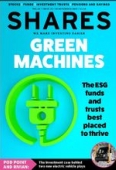Archived article
Please note that tax, investment, pension and ISA rules can change and the information and any views contained in this article may now be inaccurate.
Buy neglected logistics play DX as it delivers on growth

Established in 1975, logistics, freight and courier firm DX (DX.:AIM) has been on a journey over the last few years to reduce costs and address legacy issues.
That process is now complete and the firm is in growth mode with a strong pipeline of investments in the business so that it can ‘explode off the page’ as chief executive Lloyd Dunn explained to Shares.
The company is a key player in both the business-to-business and business-to-consumer UK delivery markets through its DX Freight and DX Express divisions.

The Freight business ranges from one-person ‘man and van’ deliveries, where it has a 15% market share similar to firms like TNT, all the way to warehouse and transport solutions with a fleet of heavy goods vehicles and warehouses.
The Express business includes a courier parcel service, secure delivery of sensitive documents and a dedicated member-to-member service providing next-day delivery within the legal, financial and public sectors.
Overall, the UK parcel market is worth around £7 billion per year, with DX accounting for around 1.5% of deliveries, and growth is running at 10% or more per year.
However, competition is fierce with players like TNT, UPS, Fedex, DPD, Hermes and Royal Mail Group (RMG) all vying for business. DX has differentiated itself with a focus on small and medium businesses and high levels of customer service.
Over the next few years DX is spending more than £20 million on improving its network, adding 15 new depots and upgrading existing sites, and investing in technology to improve the customer experience.
The firm has managed the current supply chain disruption and driver shortage and has been able to pass on higher costs to customers due to its quality of service.
The combination of higher revenues and better operating margins, thanks to embedded efficiency and productivity gains, means earnings are set to rise rapidly while strong cash flow generation helps to pay for further investments.
Yet curiously, DX shares are trading at a quarter of their value in 2017 when Dunn took over to begin the turnaround. As analyst Gerald Khoo at Liberum flagged after the firm’s forecast-beating first half results, neither the improvement in margins nor the potential for double-digit earnings growth are being priced in.
This view was echoed by FinnCap’s director of research Guy Hewett, who noted DX is on a lower rating than its peers despite offering an average of 30% annual earnings growth over the next two years, nearly three times that of its rivals.
While this could be a hangover from the company’s poor record following its 2014 IPO, we think further evidence of its improved prospects will drive a re-rating from a 2022 price to earnings ratio, based on Liberum’s forecasts, of 10.8 times.
Important information:
These articles are provided by Shares magazine which is published by AJ Bell Media, a part of AJ Bell. Shares is not written by AJ Bell.
Shares is provided for your general information and use and is not a personal recommendation to invest. It is not intended to be relied upon by you in making or not making any investment decisions. The investments referred to in these articles will not be suitable for all investors. If in doubt please seek appropriate independent financial advice.
Investors acting on the information in these articles do so at their own risk and AJ Bell Media and its staff do not accept liability for losses suffered by investors as a result of their investment decisions.

 magazine
magazine








